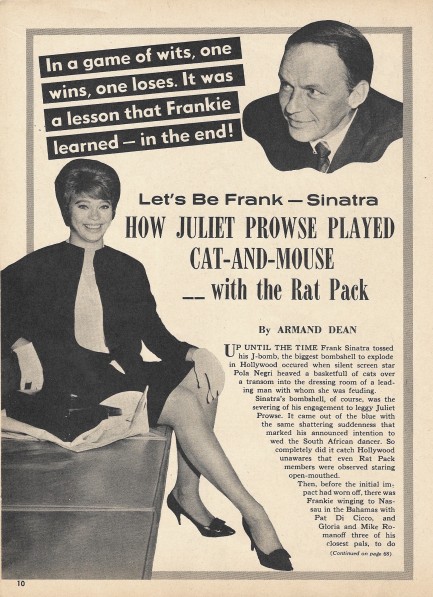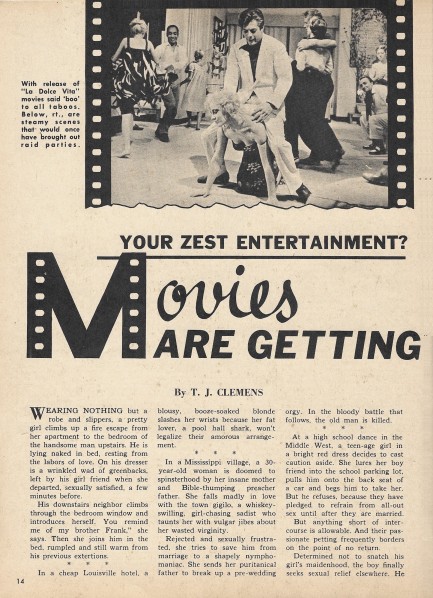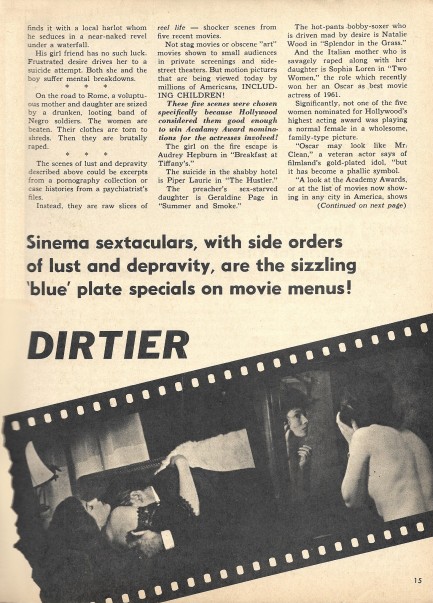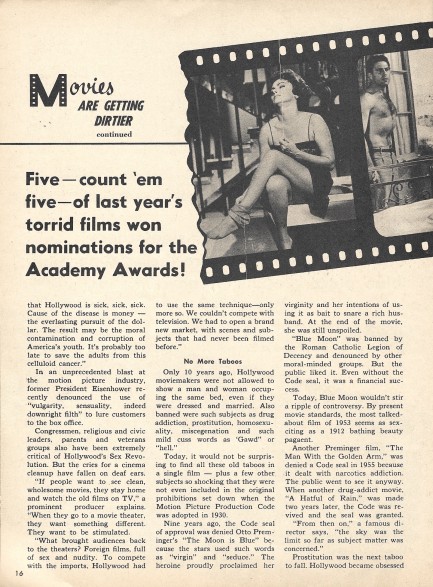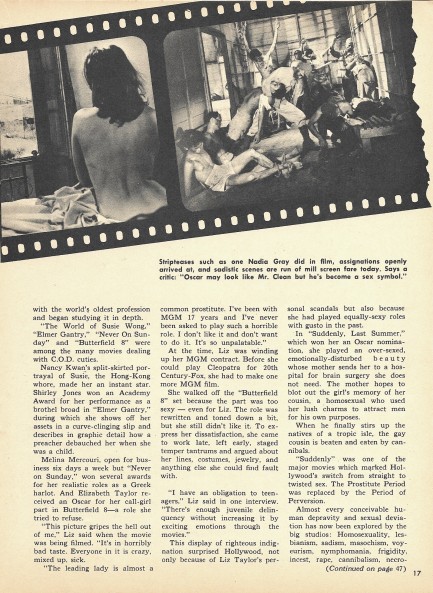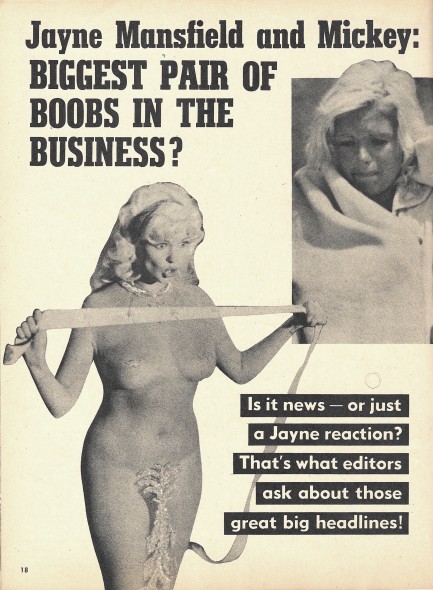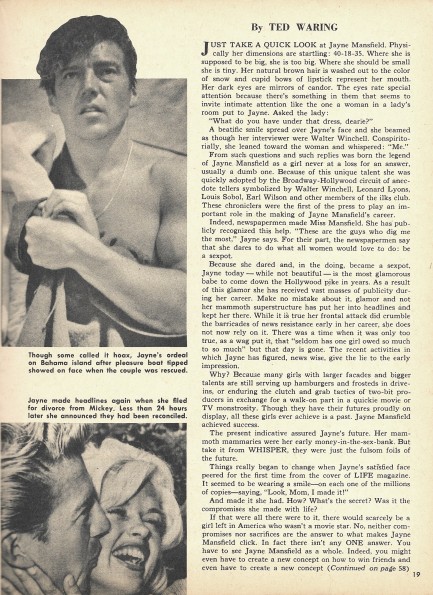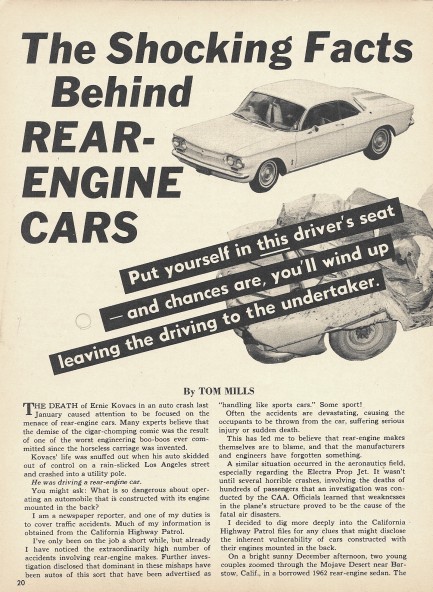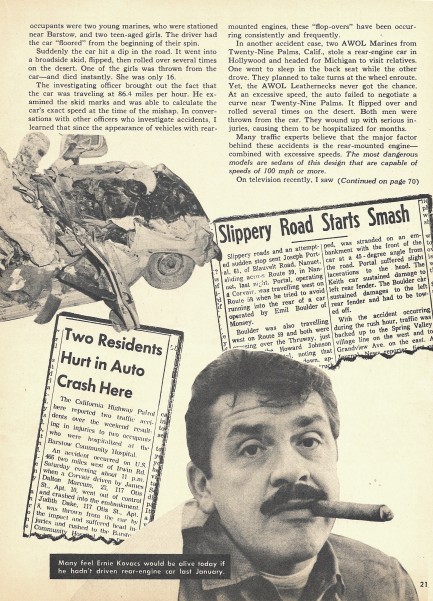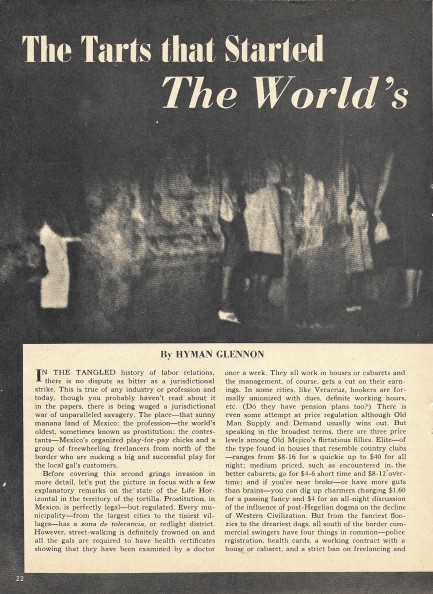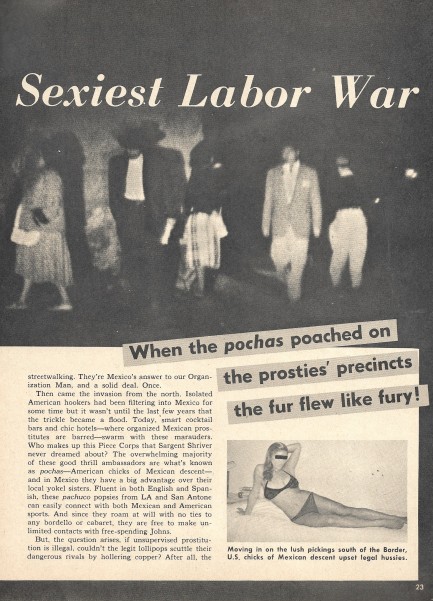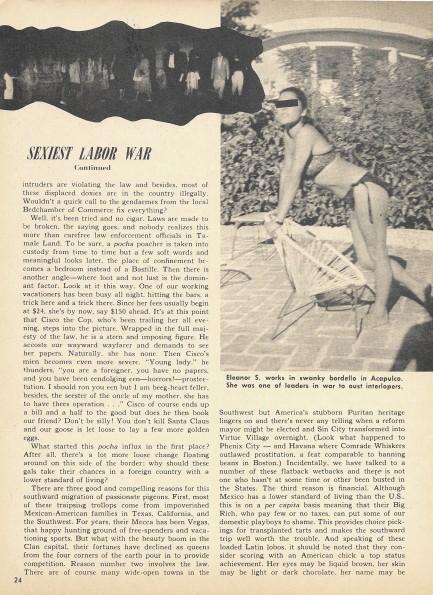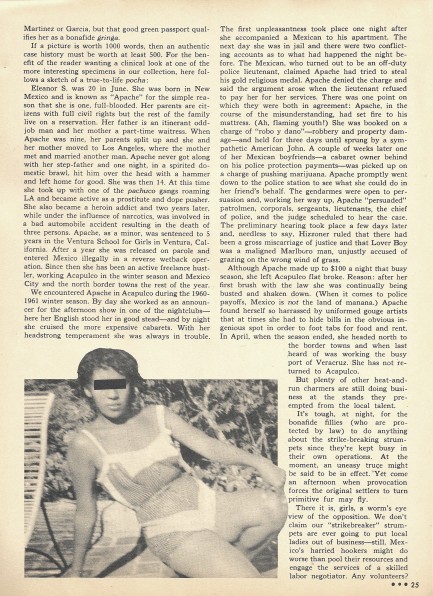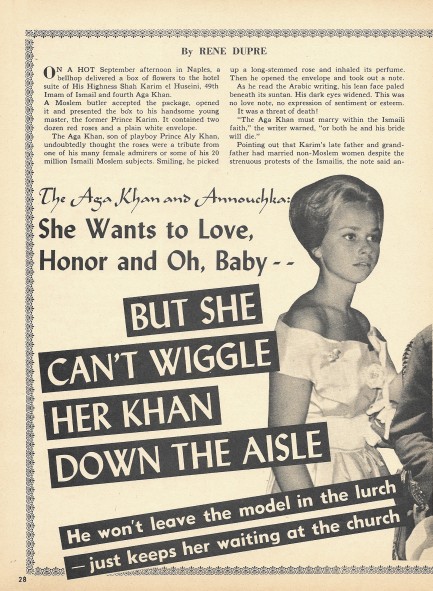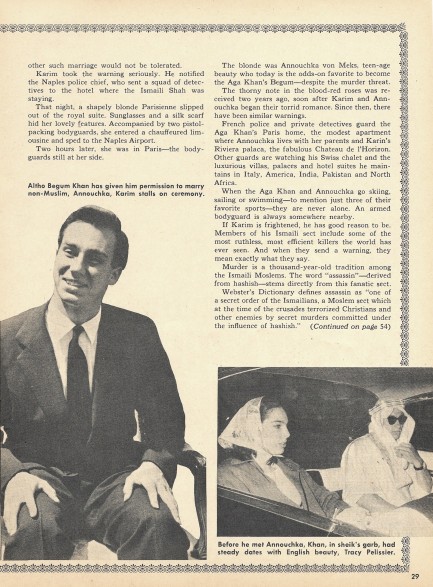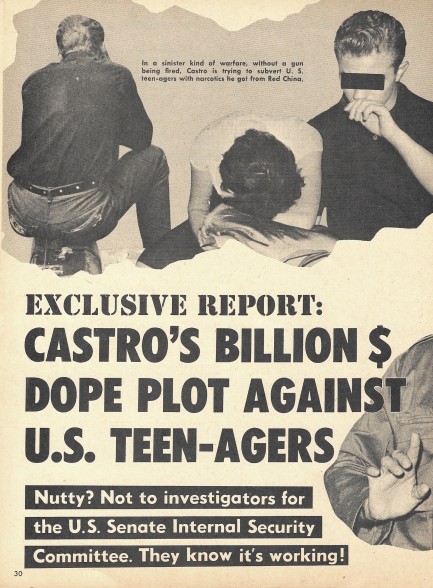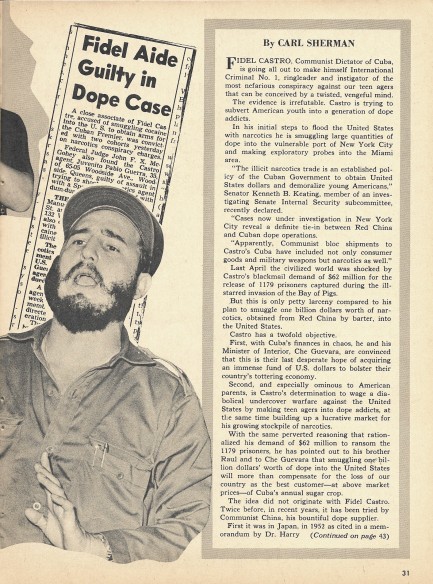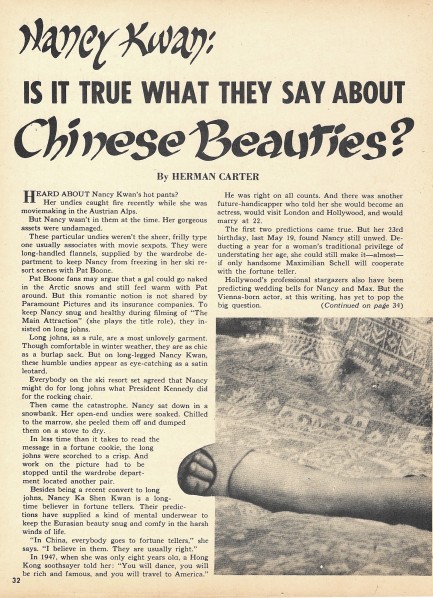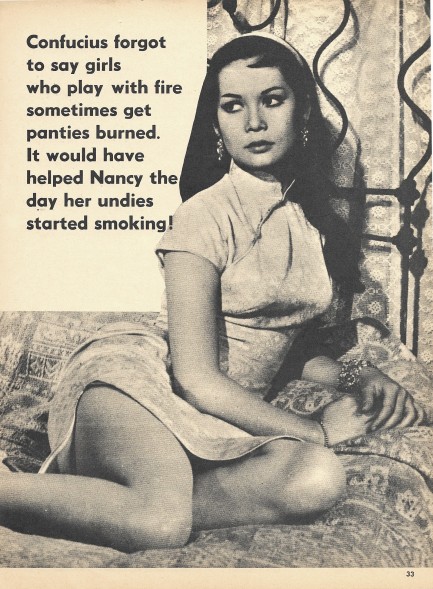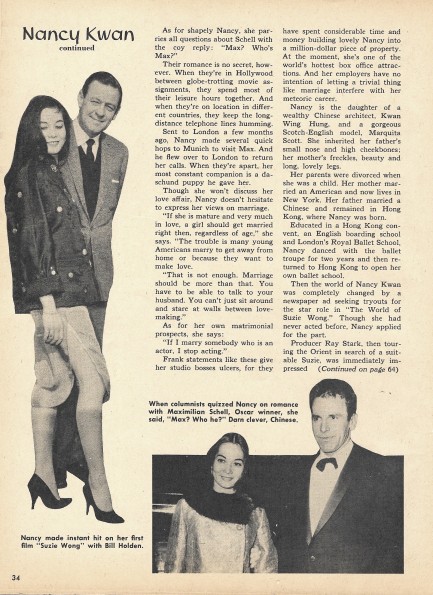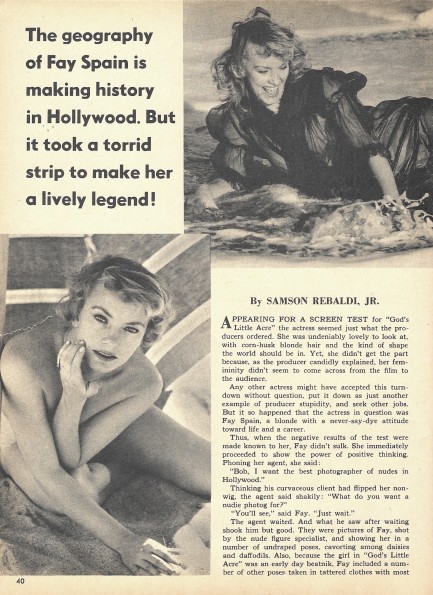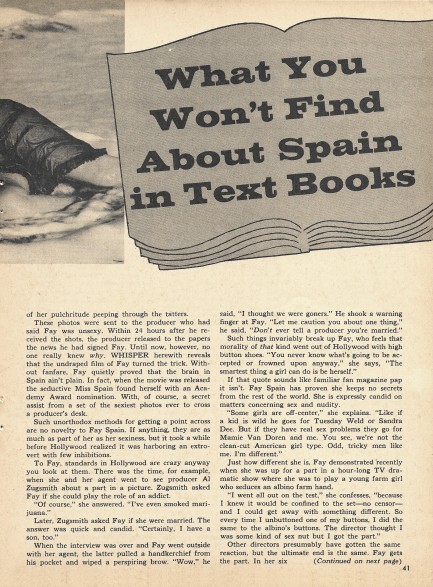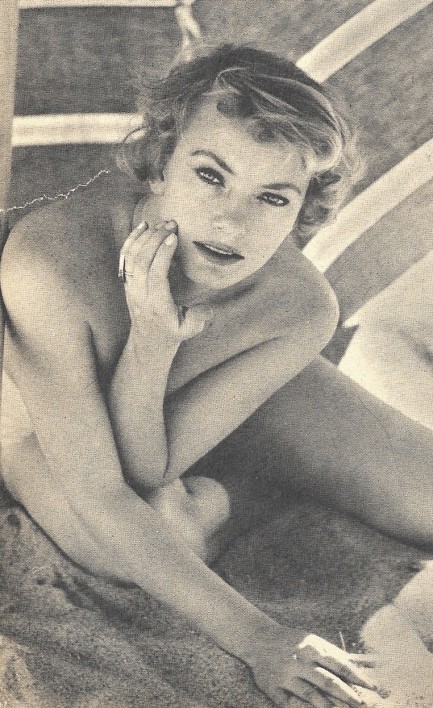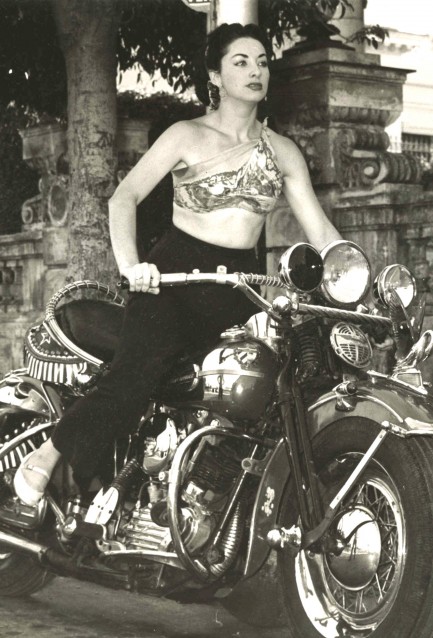 I have to admit, you're pretty good in the sack for a capitalist running dog lackey. 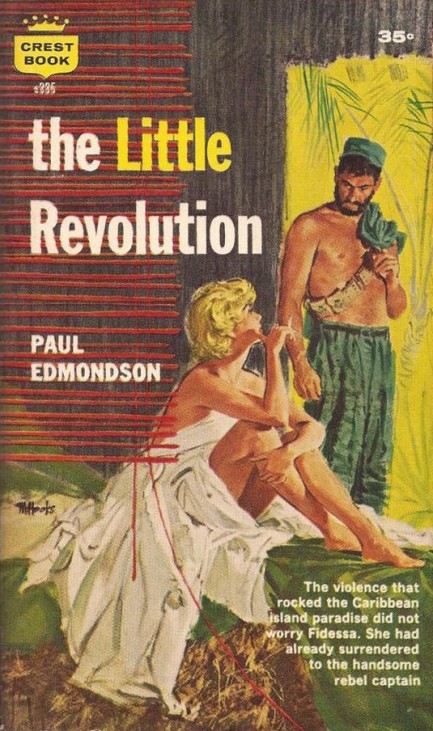
Heat, guns, passion, and politics. What more do you need for an adventure novel? Paul Edmondson's 1959 potboiler The Little Revolution is set on the fictional island of Caimanera, which is of course modeled after Cuba, where American wife Fidessa Broughton gets tangled up in a rebellion via her choice of a bedroom partner, even as her husband goes astray with a local woman, and a military captain's daughter rebels as well, in that way all teenagers do. The excellent art on this is by the eclectic Mitchell Hooks. We discussed his singular genius in detail a while back.
 They both like the beach, poetry, spicy food, and slaughtering cruel despots. They'll make a perfect couple. 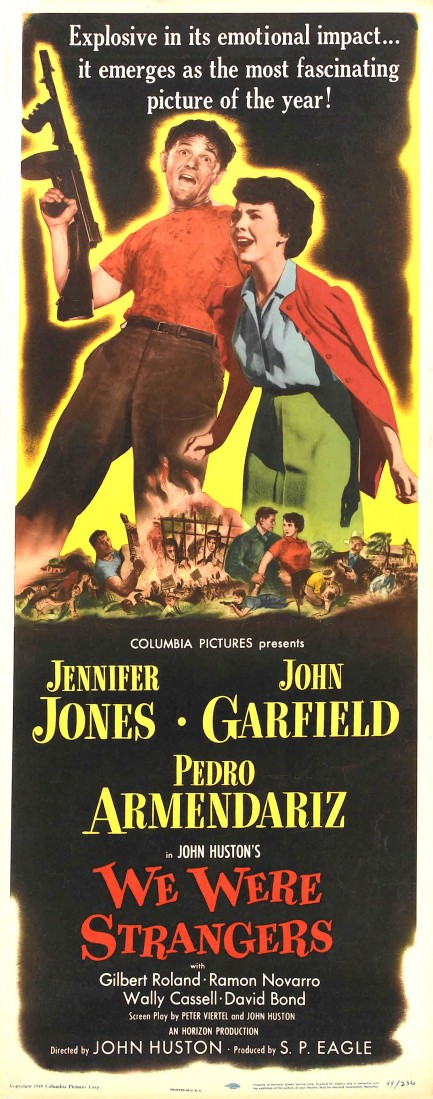 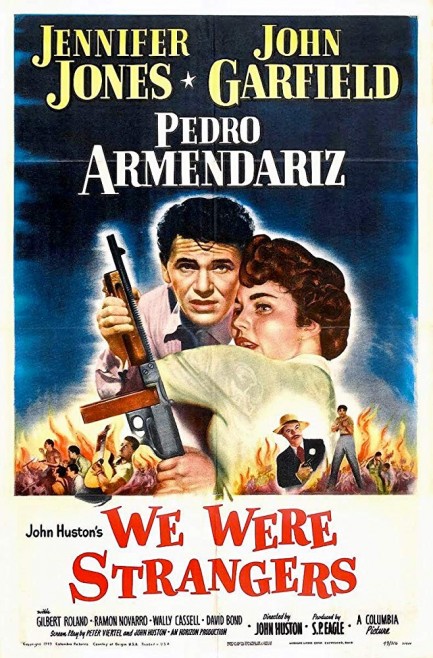
The above posters for We Were Strangers, one of which seems celebratory and another that is more dramatic, could give the impression of a studio that wasn't sure what kind of film it was trying to market. Legendary director John Huston made a habit of confounding executive suites, and here produced a film that probably came close to sending studio bigwigs plummeting in despair off high ledges. The story is set in Cuba during the early 1930s rule of dictator Gerardo Machado y Morales, and deals with revolutionaries who devise a plot to tunnel from a house near a graveyard to the site of a funeral they know the president will attend, and blow him to kingdom come with dynamite.
The movie stars John Garfield and Jennifer Jones, and is beautifully shot, but the characters aren't well written, nor are the performances sufficiently involving. There's nice action, though, especially at the climax. Since the central personalities are revolutionaries in Cuba, many critics denounced the film as Marxist propaganda, which it really isn't. It's just historical drama with unavoidable economic context. You wouldn't think it would be terribly controversial to say that for Americans to live income-wise far above the global average, substantial portions of the world must remain stuck below it, but on the other hand maybe it's understandable that we want to avoid thinking about how earning a nice profit is usually dependent upon others providing raw goods and hard work dirt cheap.
It's a shame the film isn't good enough to sweeten its message with high level drama and thrills. Huston was a workmanlike director who, despite helming numerous classics, wasn't any sort of auteur. He tried to tell stories in ways he felt was best for the material, but he also loved travel, which led him to accept projects based on the potential for exotic location work. Sometimes, as in The African Queen, he struck gold. Other times, as here, he spent a lot of investment capital and made a lot of Hollywood suits cry. We Were Strangers will be of interest to Havanaphiles, but in what was a famously up and down career, this effort comes out on the lower end of the Huston scale. It premiered in the U.S. today in 1949. 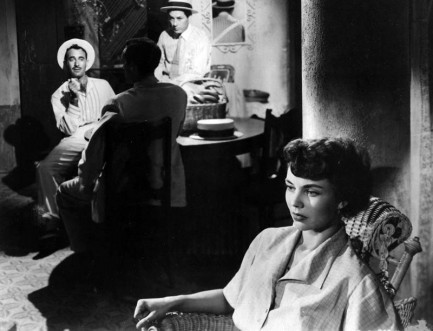 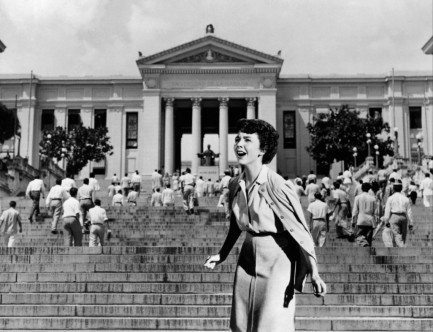 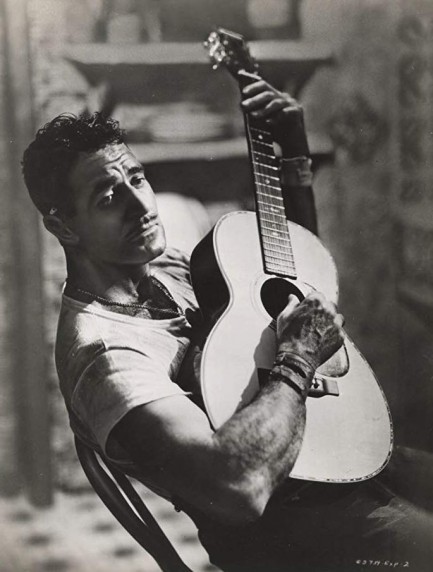 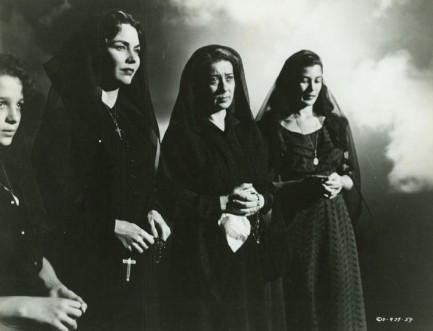 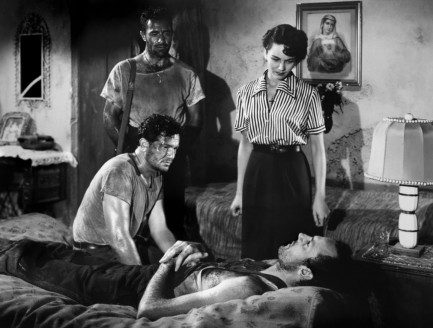 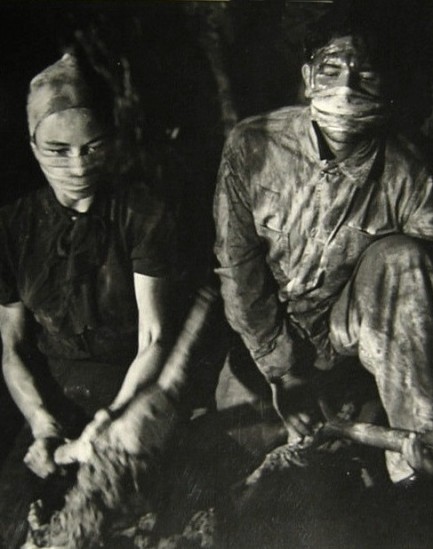
 Rat-a-tat-tat, all the men fall flat. 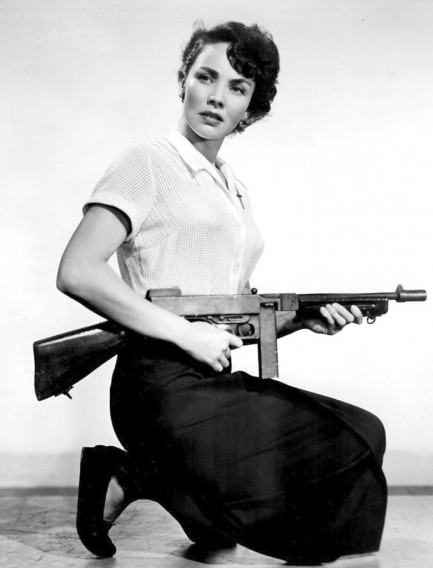
Above is a promo image of the wonderful Jennifer Jones, made for her 1948 Cuba adventure We Were Strangers, in which she played a character with the amazing name China Valdez. Wanna see her use that gun? If you watch the film, which was directed by John Huston, you'll see it happen during one of the most action packed climaxes in ’40s cinema, though the actual movie isn't one of Jones's nor the great Huston's best.
 The tabloid media was like a pack of animals and Mansfield was the meal. 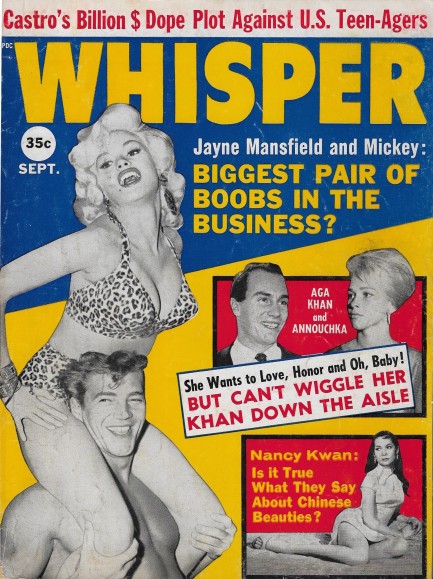
We never realized this before, but the editors of Whisper really had it in for Jayne Mansfield. We mean more than usual for a vicious tabloid. Most of the issues we have contain highly negative stories about her, such as this one published in 1962 that calls her and husband Mickey Hargitay “the biggest pair of boobs in the business.” Geez, what did she do to them? Piss in their grits? Dropkick their Corgis? Obviously, the biggest boobs thing is a play on words referencing Mansfield's bust, but they're referencing her personality when they talk about her “false façade” and “up-front ways.” Regardless of whether Whisper approved of Mansfield, it couldn't stop featuring her—a fact the magazine acknowledged. We'll see her in these pages again.
Meanwhile, elsewhere in Whisper, the amazing Señor Fidel Castro makes one of his regular appearances. Like Mansfield, the magazine couldn't stop writing about him. According to the editors, the Beard had launched a plot to addict American youth to drugs. We call Castro amazing because according to various mid-century tabloids he was simultaneously training Viet Cong soldiers in Cuba, funneling arms to U.S. inner cities, assassinating JFK, planning to overthrow the Catholic Church, raping teenaged girls, and helping East Germany revive the Third Reich. Talk about great time management skills. If only we were half as organized.
Did drugs flow from Cuba to the U.S.? It's an accusation that has come up numerous times over the years. Considering that since at least 1950 drugs were flowing into the U.S. from Colombia, Mexico, Peru, Brazil, Afghanistan, Thailand, et al—it would be astonishing if drugs didn't also originate from or transit through Cuba. With what degree of official approval we'll probably never know. Heads of state are notoriously insulated. In fact, the only one we can think of offhand who was definitively tied to drug dealing was Panama's former strongman Manuel Noriega, who was doing it with the full knowledge of the CIA, but we can probably safely assume he wasn't the first national leader to peddle drugs.
Whisper isn't aiming for investigative journalism in its Castro piece. That would require actual work. Its story is 90% lollipop, 10% stick. But the ratio of fiction to fact is meaningless as long as the writing fits the brief: focus obsessively on the sensational, the frightening, and the infuriating. That's why we call mid-century tabloids the cable news channels of yesteryear. Though people were doubtless highly agitated about what they read in these quasi-journalistic outlets, the passage of decades makes them harmless fun for us to explore. Maybe one day a future website—or whatever passes for one ages from now—will be able to make jokes about the things agitating us. Let's hope so. We have a bunch of scans below, and more tabloids than we can count inside the website. Look here.
 Two wheels, a road, and a full tank of gas. 
Singer and dancer Lina Salomé poses on a monster motorcycle in Havana, Cuba, sometime in 1956. Born Luz de Peña Matos Estévez, she appeared onscreen seven times between 1952 and 1957. She had only one leading role, in the Mexican made Alma de acero, aka Soul of Steel. Another film, Los tres bohemios, appeared a month later, but the work dried up completely after that. However, we've seen her described as an iconic musical figure in Cuba, and this photo fits for someone remembered that way. It's probably just a publicity shot, but we like to think of her actually taking this machine to Matanzas on the Via Blanca, because a beast like this needs to eat a lot of road. If you want to see Miss Lina do a little song and dance, check this link while it lasts.
 Spanish art for Casa número 322 may have traveled far from home. 
We already showed you a beautiful yellow French promo poster for 1954's Pushover, starring Fred MacMurray and Kim Novak. Above is a cool blue Spanish language promo. This piece is signed MCP, which is the imprimatur used by the Spanish artists Ramon Marti, Josep Clave, and Hernan Pico. So is this a Spanish poster? Well, most online sites say so. But the distributor for Mexico is listed as Columbia Films S.A., and you can see that graphic right on top of the poster. The S.A., by the way, stands for “sociedad anónima,” and is a corporate designation, kind of like Inc., or LLC. The movie's distribution company for Spain is on record as plain old Columbia Films, with no S.A., so we think this poster was used in Mexico, where the movie played as La casa número 322, “house number 322.” There's no exact Mexican release date known for it, but late 1955 is a safe bet. All that said, there's no way we can claim to be correct with 100% surety that this is a Mexican poster. We're extrapolating.
Columbia had distribution branches in various Latin American countries. Its Mexican hub was the most important because Mexico had the most developed Spanish film market in the world. Yes, more than Spain, which was still recovering from civil war. Though dubbed or subtitled versions of foreign movies were routinely shown in Mexico, locally produced flicks were about 20% more popular at the box office on average, according to a 1947 report circulated by the U.S. Consulate in Monterrey. In fact, Mexican films were the most popular in all Latin America, particularly Cuba. Even in Mexico City, where U.S. and European films were more popular than anywhere else in the country, Mexican films took up more than 40% of exhibition time—again as reported by the U.S. Consulate. Why was the consulate studying this? Just wait.
The Mexican movie market isn't as competitive today. The decline was due to three main factors: political pressure that forced Mexico to submit to so-called free trade in mass media, suspicious difficulties obtaining raw film stock from the U.S. for movie productions, and, of course, dirty business tactics by Stateside studios. So that's where the consulate came in—gathering intelligence for both the U.S. government and U.S. business interests. Armed with alarming data about local preferences for local product, U.S. studios forced Mexican exhibitors into “block booking” agreements, which meant that if cinemas wanted to exhibit the best Hollywood films they were also contractually obligated to take on the worst. This was repeated all over Latin America, and those bad films, which were more numerous than the good ones, ate up exhibition hours and kept Mexican films off screens. Pushover, at least, was one of Hollywood's better films.
 In the Aztec version of the show being sacrificed on a cross is actually first prize. 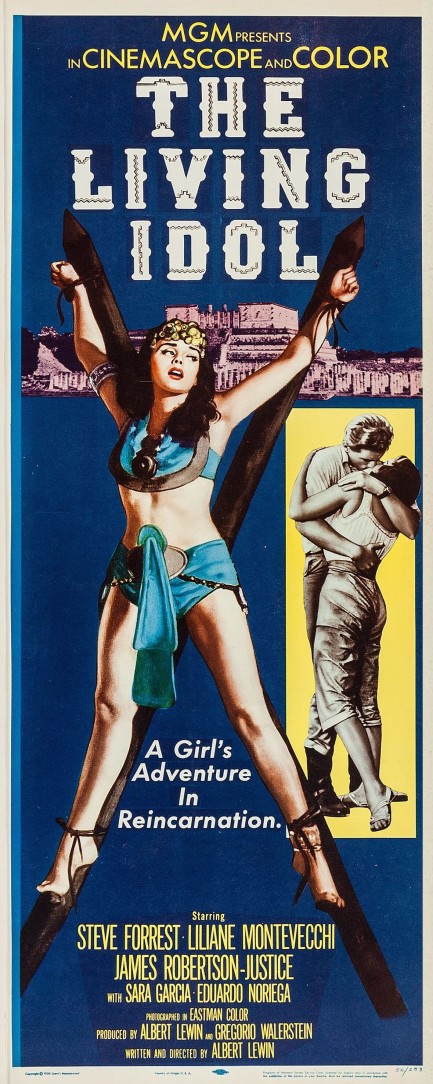
This poster for The Living Idol gives a bit of a false impression. The movie isn't the lost world epic implied by the art. Most of it is set in and around the University of Mexico, and deals with an archaeologist who believes he can unlock the secrets of ancient Aztec rituals by using a colleague's daughter as a sort of medium. James Robertson Justice is the obsessed archaeologist, and French actress Liliane Montevecchi stars as Juanita, who may have some mystical connection to the ancient world.
The movie is better than you'd expect. It's serious and intelligent, with a bit of cuteness mixed in, and what's particularly striking is the respect it shows—for a U.S. made movie—toward Mexico and Mexican culture. The default attitude for Mexico in north-of-the-border movies from the period is one of mild patronization, but not here. Give some credit to screenwriter Albert Lewin, but more credit to director René Cardona, who's Cuban, not Mexican, but was certainly versed in the culture and history of the country.
Though no Mexicans appear in major roles, Cardona manages to leave viewers with a sense of wonder about Mexico, and not just its mythic past, but its contemporary aspects too. He treats viewers to a nice tour of the Universidad Nacional Autónoma de México, built in Mexico City in 1910, and one of the most majestic and beautiful centers of learning in the Americas today. Its central campus, built from 1949 to 1952, is even UNESCO protected, which thousands of older universities can't say.
This comes in addition to amazing panoramas of the Aztec ruins at Uxmal, probably the best represented they've ever been in a motion picture. Is the movie good? Not quite. It has many rough patches, and Montevecchi has only two expressions in her acting arsenal—innocent eyed, and bug-eyed. But it all works a bit better than it should, somehow. We cautiously recommend it for Mexicophiles, but keep your expectations in check. The Living Idol opened in the U.S. today in 1957. 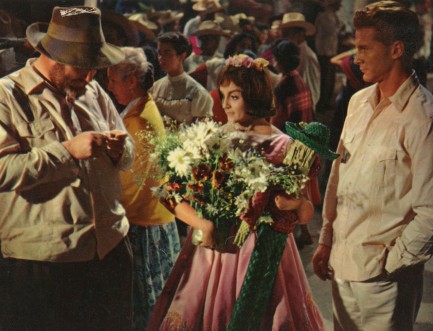 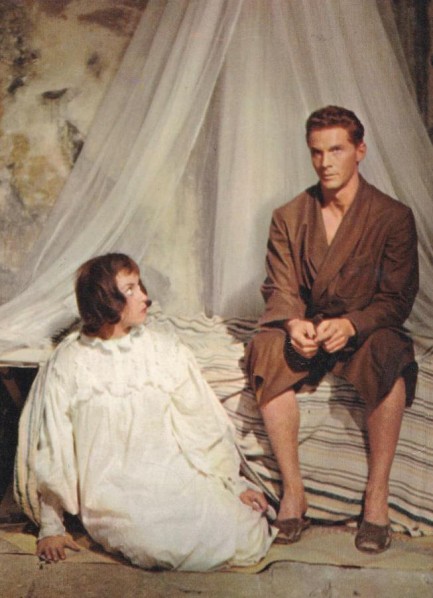  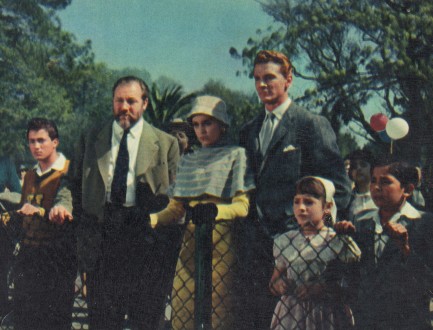  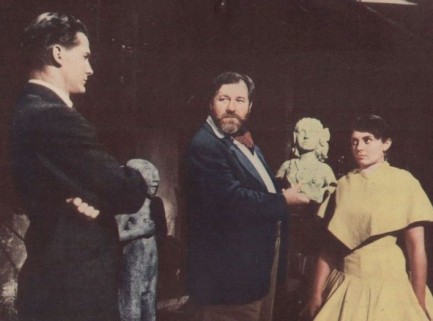  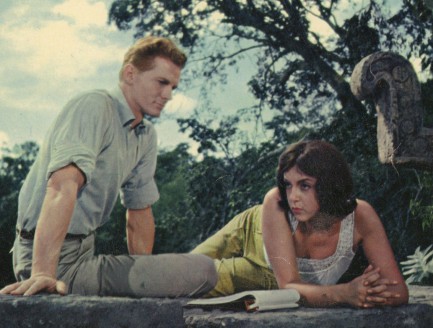 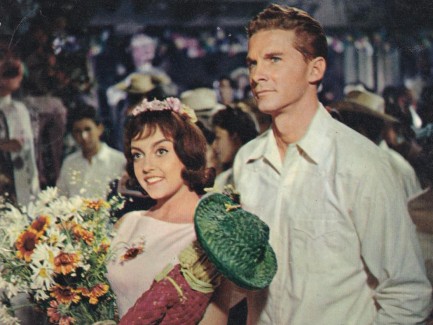 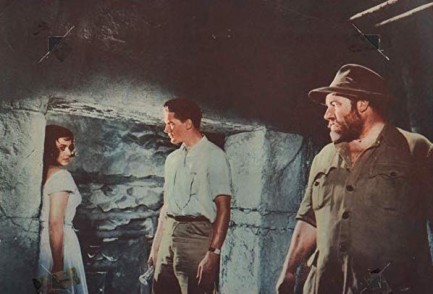 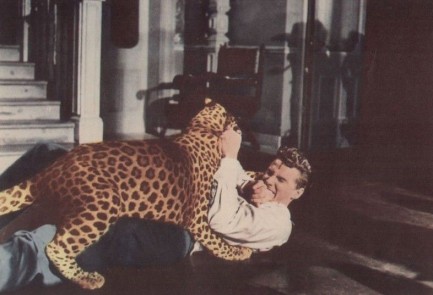  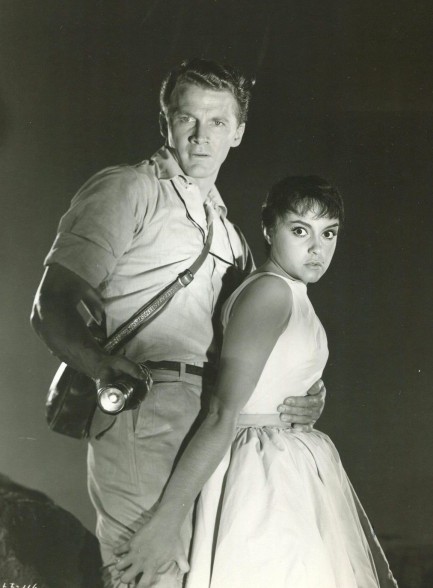 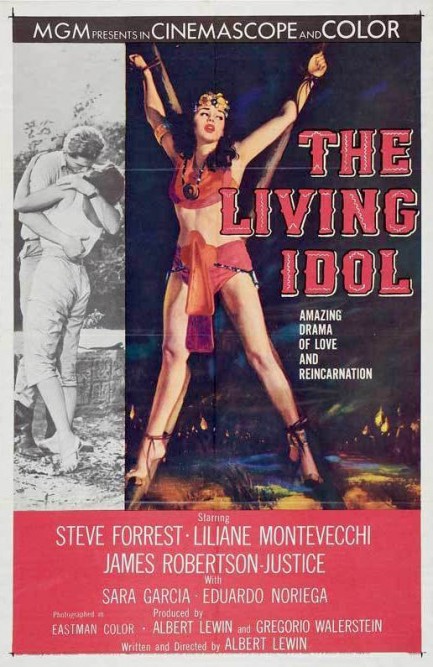
 A signing of things to come. 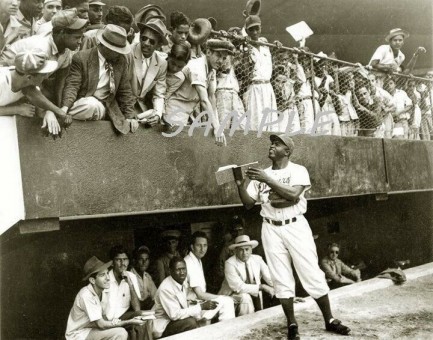
Above is a photo of Brooklyn Dodgers star Jackie Robinson signing autographs for Cuban fans in Havana during the spring of 1947. The Dodgers had used Havana’s La Tropical Stadium as their spring training base during the 1941 and ’42 seasons, and went there again in ’47 to avoid some of the publicity and hostility that would have surrounded Robinson, who was destined to be the first African American baseball player of the modern era. Even away from U.S. shores it was a trying time for Robinson. Havana was run by Americans interests, and was selectively an apartheid city. Robinson stayed at the Hotel Boston in Old Havana, rather than the grand Hotel Nacional in swanky Vedado with the white Dodgers. This annoyed Robinson, but he needed to focus on his play because, though he had been invited to spring training, he was not guaranteed a Major League roster spot. The pressure must have been intense. Even so, in this photo he takes time to sign autographs for Cuban fans, gracious as always, on the cusp of a career that would redefine what it meant to be a Major League Baseball player.
 Lust is in the air according to Adam magazine. 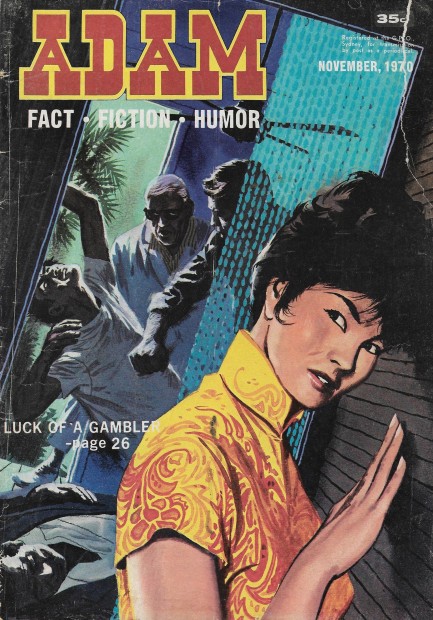
Every issue of Adam magazine is a joy to read, but some are more laden with goodies than others. In this case, among many worthy stories there's “Sky-Diving Love Kittens,” “Trapped by Terrorists,” and “Free Love Females of the Arctic.” How can you make a choice there? Especially since all three stories are labeled “FACT.” Turns out “Sky-Diving Love Kittens” is about how women become sexually aroused by freefall. The journalist narrator would have readers believe he was writing about a group of female sky divers, and when they landed they hustled him off to a shack and rocked his world. Do we buy this? Not really. But we love the story.
All you need to know about “Trapped by Terrorists” is that it takes place in Cuba. The rest is rote adventure writing using a formula well established in mid-century literature. The Cuban men are cruel (and bearded), while the Cuban women are hot (and beaded with sweat). All the girls require to escape the bonds of totalitarianism is a few gringos to make landfall. Before you know it, like being exorcised of demons, the power of penis compels them to face down their oppressors. Do we buy it? No. But while silly and propagandist, it's also entertaining. Sign us up for any writings of this style, whether “fact” or fiction.
And finally “Free Love Females of the Arctic” deals with the sole survivor of an Arctic shipwreck who's rescued by Eskimos when he was on the precipice of becoming a popsicle. Back in the village, two women strip down and warm him by wriggling all over him under fur blankets and nibbling on his chest, then the clan gives him a temporary wife while he's waiting to be returned to civilization. His popsicle thaws and is put to good use. We don't buy this tale either, but we buy Adam magazine—every chance we get—because it's incredibly entertaining. We have thirty-plus scans below and dozens more issues in the website just waiting for you to discover. 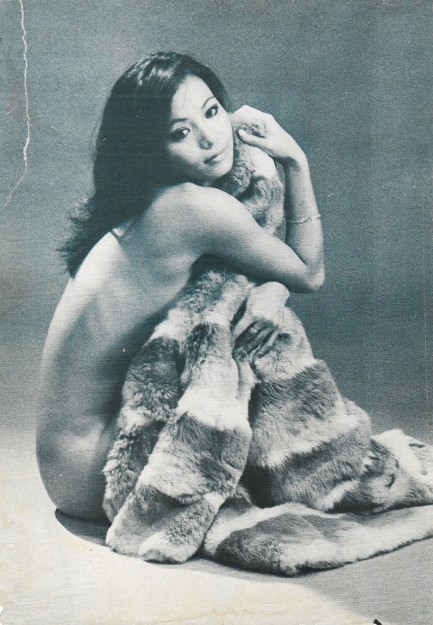 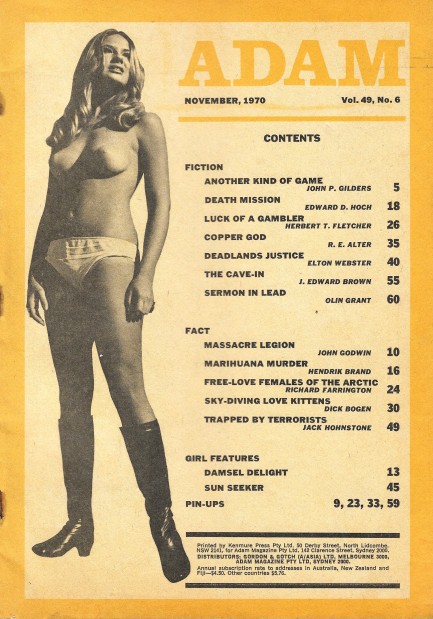 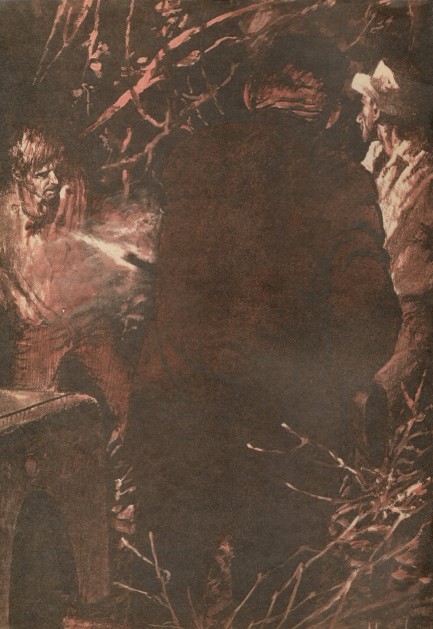 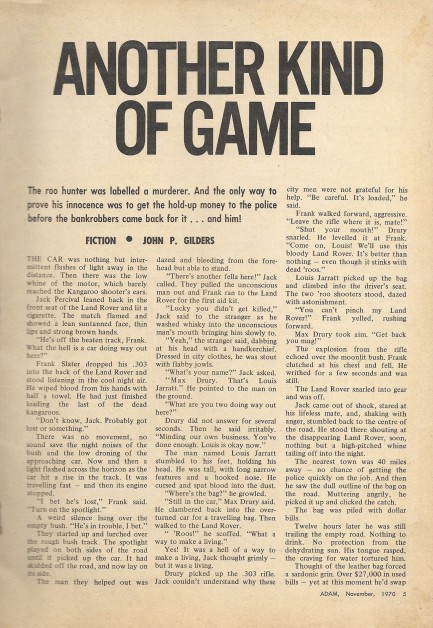 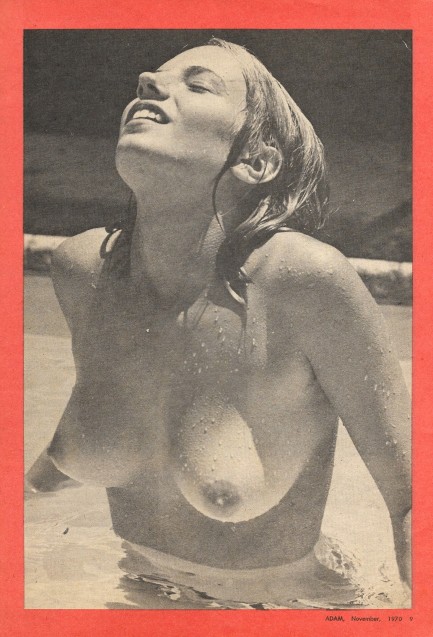 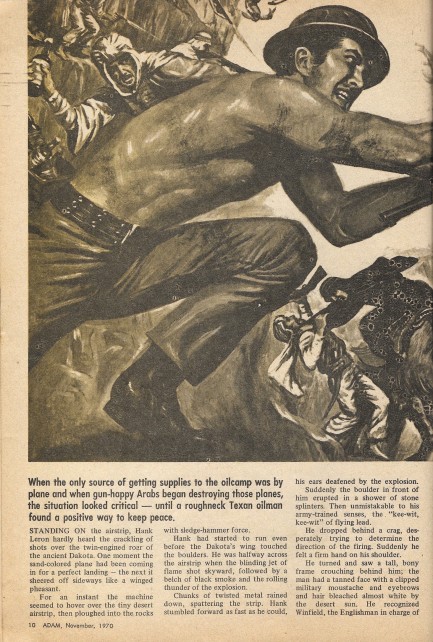 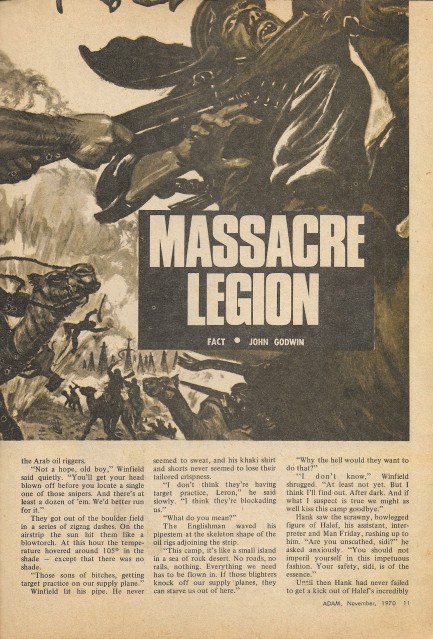 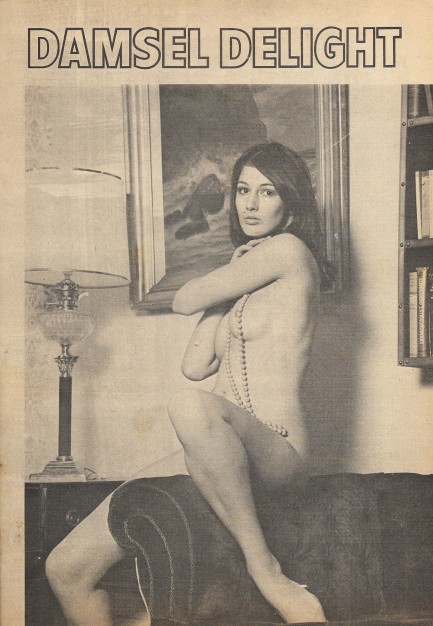   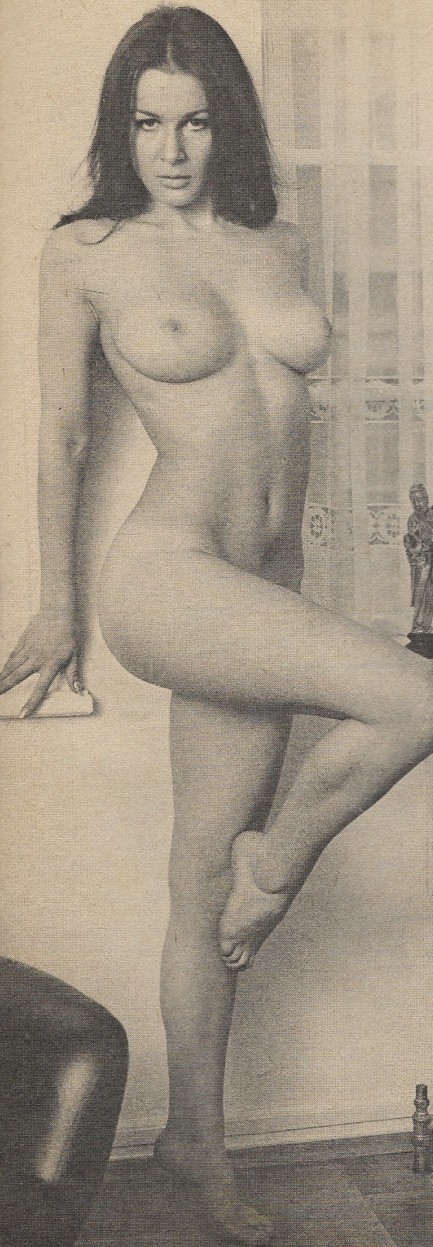 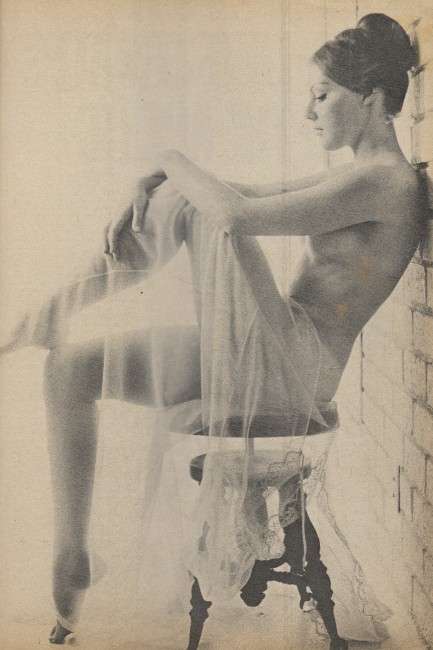 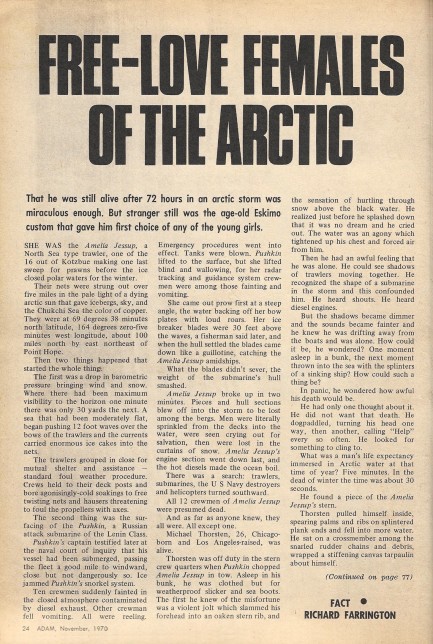 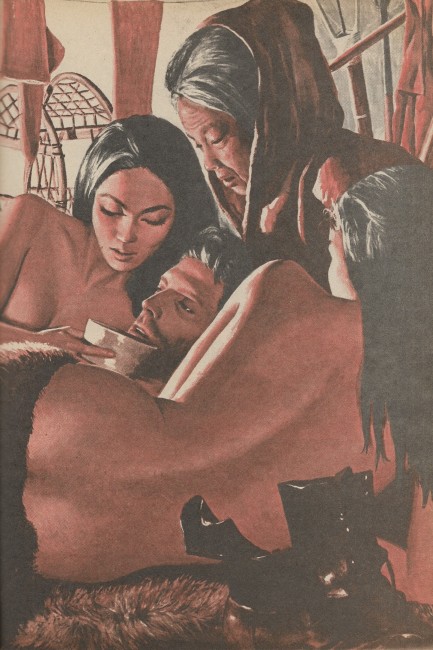 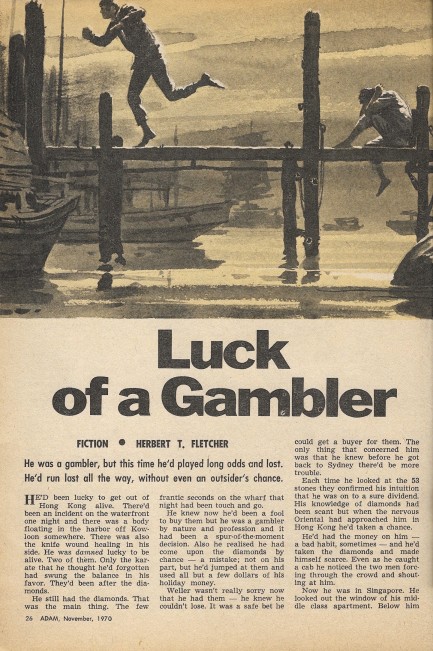 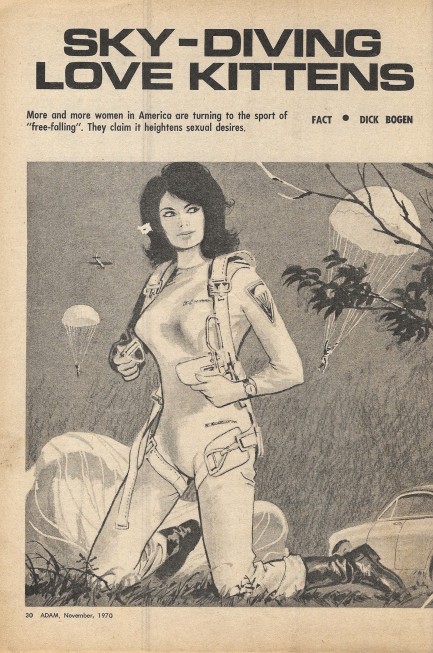 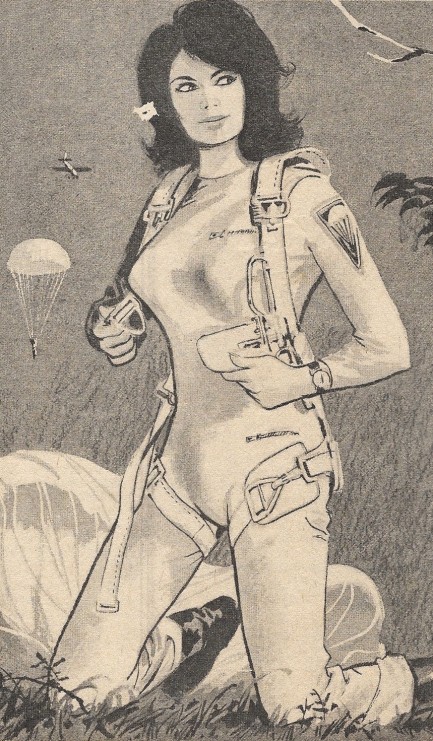 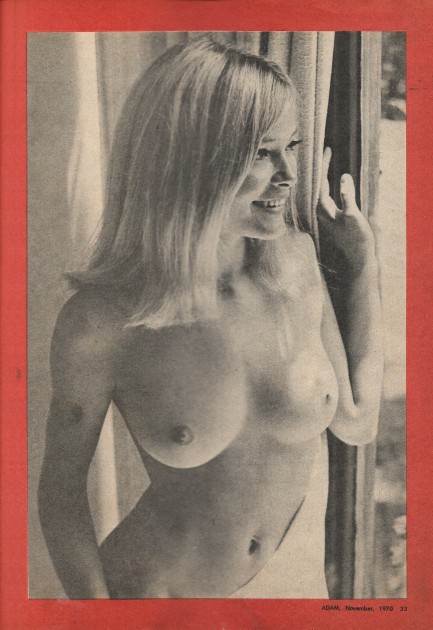 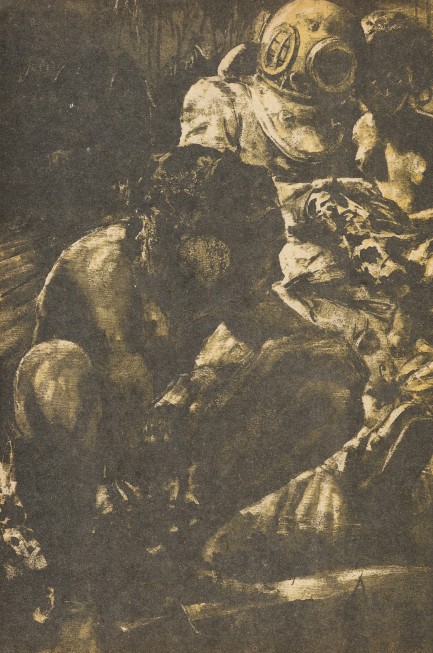 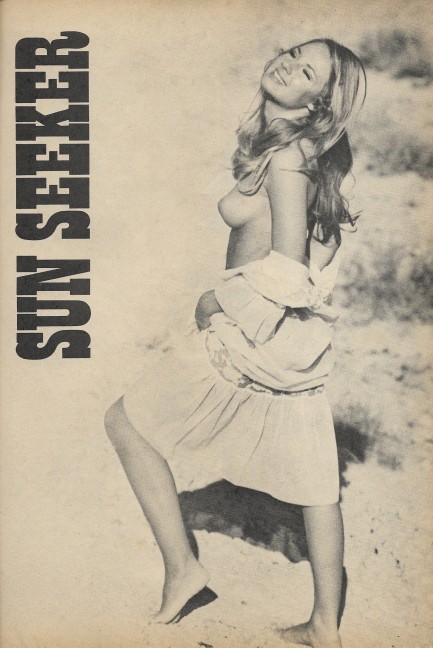 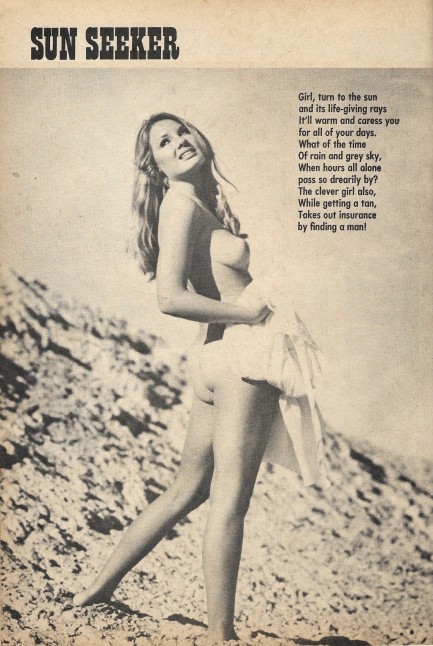 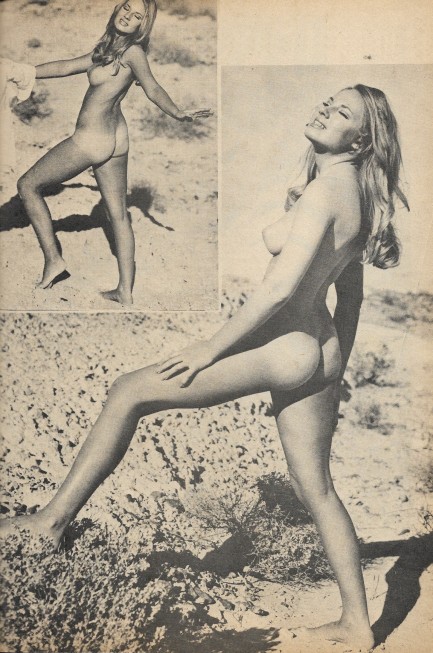 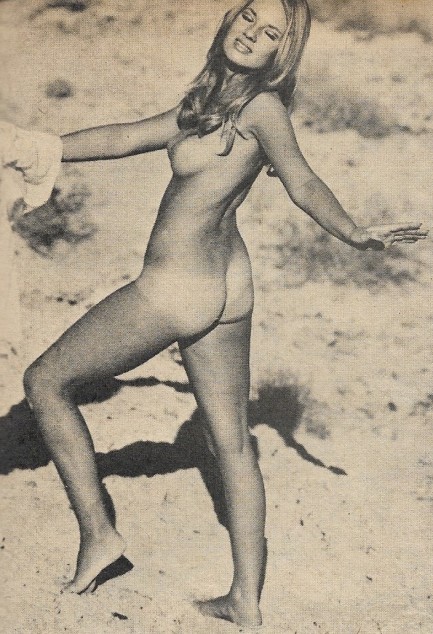 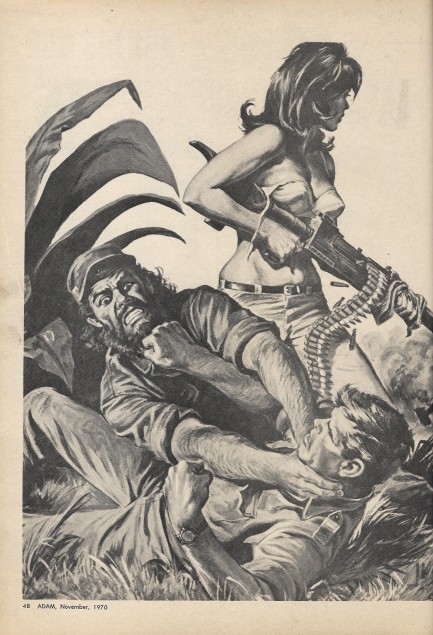 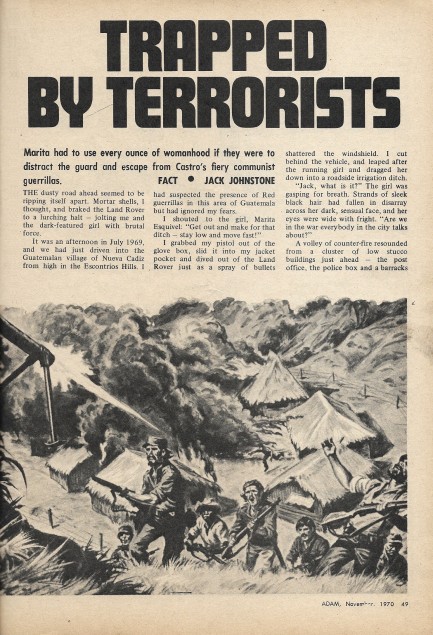 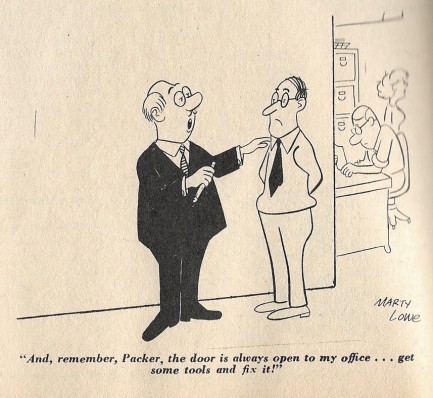 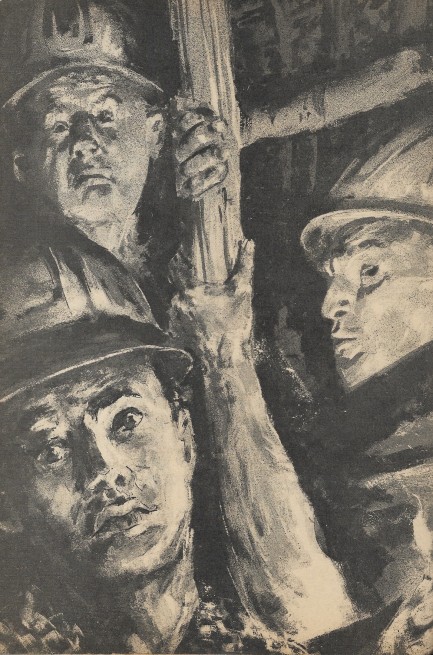 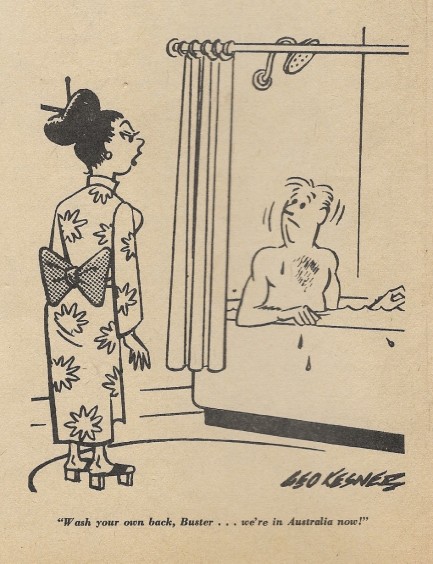 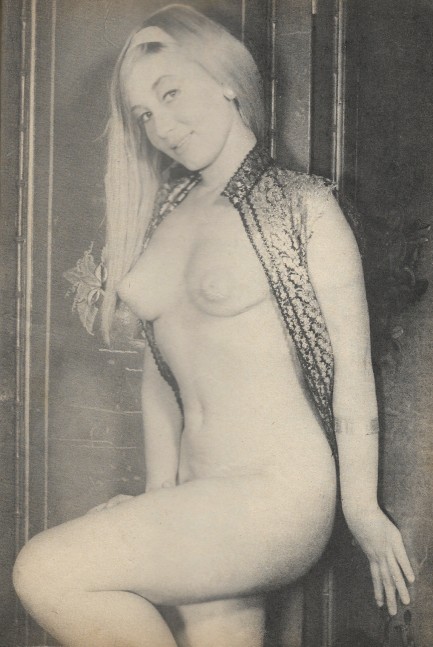
 Cuban program to clone Fidel Castro goes horribly wrong. Multiple Castros result—but all are rampaging capitalists. 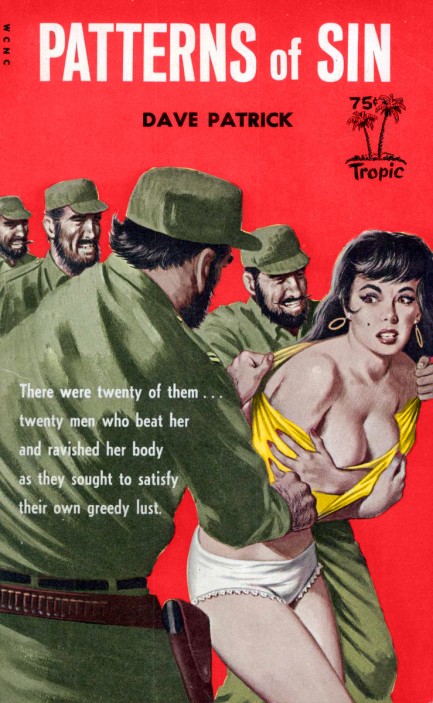
The lead character in Dave Patrick's 1965 novel Patterns of Sin is a college professor and ex-CIA operative named Thomas Keith who happens to be a millionaire. Only in sleaze fiction, right? When his latest girlfriend is almost kidnapped by rogue Cubans, he suspects there's more to her than meets the eye, and there is—she fled to the U.S. after some particularly sticky island dealings involving a long lost twin brother/incestuous lover who was a famed counter-revolutionary. Sadly, there are no clones, but who needs 'em? The incest angle is weird enough: “Tom had so reminded her of her brother that she'd almost called him by her brother's name as they made love.” She actually tells Thomas about her brother, and he's fine with it.
“Are you sure, Tom?” she whispered.
“Do the other women I've had bother you?”
“No, but men are supposed to be different. They're supposed to want virgins.”
“Every girl's a virgin to me, until I've made love to her.”
The government is interested in Tom's girlfriend and her Cuban connection, so he's brought back into the CIA, given a hot partner and—this being a sleaze novel—the partner is a woman with whom he has a steamy history. But they don't get together—the partner is gay now, prefers the Cuban girlfriend, and gets her. Thomas's reaction? “It's a waste of a beautiful woman as far as I'm concerned, but it's your life.” You may be wondering if there's any actual plot here. Not enough to matter. The anti-commie aspect is a mere placeholder between love scenes. The book was bad. We knew it would be bad. But we had to find out what it was about. It wasn't about clones the way the cover art might make you think, but maybe it should have been. That art, by the way, is by Bill Edwards—the mole on his female figures always gives it away.
 |  |
|
 |

The headlines that mattered yesteryear.
1927—Mae West Sentenced to Jail
American actress and playwright Mae West is sentenced to ten days in jail for obscenity for the content of her play Sex. The trial occurred even though the play had run for a year and had been seen by 325,000 people. However West's considerable popularity, already based on her risque image, only increased due to the controversy. 1971—Manson Sentenced to Death
In the U.S, cult leader Charles Manson is sentenced to death for inciting the murders of Sharon Tate and several other people. Three accomplices, who had actually done the killing, were also sentenced to death, but the state of California abolished capital punishment in 1972 and neither they nor Manson were ever actually executed. 1923—Yankee Stadium Opens
In New York City, Yankee Stadium, home of Major League Baseball's New York Yankees, opens with the Yankees beating their eternal rivals the Boston Red Sox 4 to 1. The stadium, which is nicknamed The House that Ruth Built, sees the Yankees become the most successful franchise in baseball history. It is eventually replaced by a new Yankee Stadium and closes in September 2008. 1961—Bay of Pigs Invasion Is Launched
A group of CIA financed and trained Cuban refugees lands at the Bay of Pigs in southern Cuba with the aim of ousting Fidel Castro. However, the invasion fails badly and the result is embarrassment for U.S. president John F. Kennedy and a major boost in popularity for Fidel Castro, and also has the effect of pushing him toward the Soviet Union for protection.
|

|
|

It's easy. We have an uploader that makes it a snap. Use it to submit your art, text, header, and subhead. Your post can be funny, serious, or anything in between, as long as it's vintage pulp. You'll get a byline and experience the fleeting pride of free authorship. We'll edit your post for typos, but the rest is up to you. Click here to give us your best shot.

|
|















